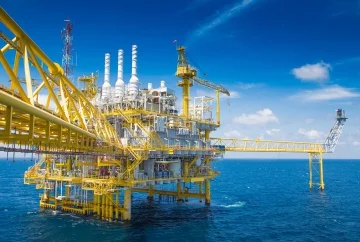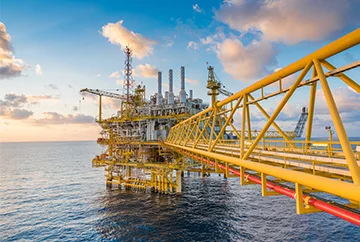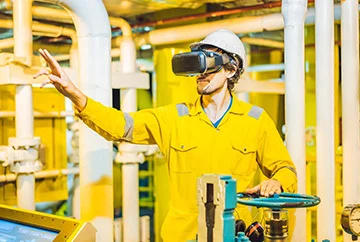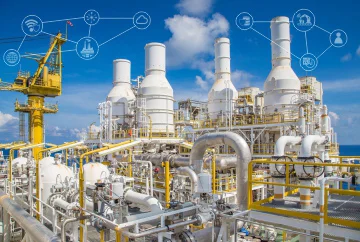#4 Asset Tracking and Maintenance/Digital Twins
Asset management, including its monitoring and maintenance, project planning, and lifecycle management, is one of the most critical areas where digital twin (DT) technology can play a crucial role.
According to
ARC Web analysts, today, roughly 63% of the oil field assets are past the halfway point of their expected lifetimes, which eventually poses great difficulty in knowing the precise status of equipment.
In such a scenario, Digital Twins enable oil & gas companies to address challenges, including production imbalances, rapid changes in global economic conditions like the COVID-19 pandemic, and equipment reliability issues.
To be responsive in these busy and somewhat chaotic times, oil and gas companies need systems with real-time visibility and flexibility provided with digital twins.
#5 Defect Detection
One of the challenges that the oil & gas companies encounter is detecting inappropriate threading in pipelines or defects in fault-susceptible processes. Defects noticed at the end of the production line from upstream issues ensue considerable losses to the factory and budget resources.
To this end, AI can help validate production quality and provide deep insights into defects in analytics. AI-powered Defect Detection solutions are cost-effective and are extremely economical in comparison to the fundamental processes.
Pattern recognition utilizing deep learning allows video streams recorded with cameras to alarm if an employee is not adequately dressed for the set of operations. Moreover, predictive analytics alarm the operators on the equipment's health state, enabling pro-active actions to prevent a catastrophe with the consequences to health, safety, and environment.
13 Remarkable Applications of AI in the Oil & Gas Industry
Click to zoom in
#6 AI-led Cybersecurity
With the Ponemon Institute survey, Siemens stated that nearly 70% of oil & gas organizations had endured security compromises.
PwC's Global State of Information Security Survey revealed that 42% of energy enterprises admitted being victims of phishing attacks.
The rise in the number of physical and cyberattacks and its security spending have necessitated the need for artificial intelligence tools to encrypt the working system into their enterprise's security. Video cameras as sensors help in monitoring the security threats in the utilities all day. When it is combined with software, the utilities get secured to every endpoint.
#7 Workplace Safety
Operations on the oilfields pose risks for personnel as it involves heavy equipment, non-covered rotary equipment, high pressure, high-temperature operations, and aggressive chemicals. A
Science Direct study, 'Artificial intelligence in oil and gas industry upstream: Trends, challenges, and scenarios for the future,' points out that many IT systems based on deep learning helping the safety officers spot safety protocols' violence.
Operations on the oilfields pose risks for personnel as it involves heavy equipment, non-covered rotary equipment, high pressure, high-temperature operations, and aggressive chemicals. A Science Direct study, 'Artificial intelligence in oil and gas industry upstream: Trends, challenges, and scenarios for the future,' points out that many IT systems based on deep learning helping the safety officers spot safety protocols' violence.
#8 Analytics-Driven Decision Making
'DATA is the new OIL' is the highly used term these days, and in the case of O&G, it's a perfect metaphor. Oil and gas businesses deal with lots of data coming from manufacturing processes. Still, due to a lack of proper analytics tools, they cannot capitalize on the massive data resting in data silos. AI algorithms examine various data streams from various sensors and machinery of different plants or entire Geoscience data and obtain real-time analytics to generate rational ideas based on business needs.
#9 Emission Tracking
According to a
McKinsey report, several oil and gas companies have already set net-zero emissions targets. Despite the economic challenges, many companies are working towards decarbonizing their operations and value chains. Occidental Petroleum – A US O&G company, has partnered with Carbon Engineering – a Canadian start-up, to ensure that the plant they build captures and buries 500,000 metric tons of CO₂/year.
BCG studies state that the potential overall impact of applying AI to corporate sustainability amounts to $1.3 trillion to $2.6 trillion in value generated through additional revenues and cost savings by 2030.
Oil producers also are deploying AI software to keep track of the volumes of fugitive emissions of greenhouse gases that escape from pipelines and oilfield equipment; the better to control them. Upstream oil companies are also using AI to optimize the storage of CO₂ for enhanced oil recovery.
#10 Logistics Network Optimizations and Logistics
The supply chain in the oil and gas sector is a complex operation involving decision nodes such as crude purchase, purchase price, transportation to the refinery, refining operations, gantry operations, and retail sale of end products. In the upstream business, AI helps coordinate the operations team with the warehouse to ensure the availability of crucial parts.
In midstream business, AI can support proper planning and execution, optimal route selection, etc. In contrast, it helps refiners plan optimal blending, forecasting the demand, estimating prices, and improvising customer relationships in the downstream business. In a nutshell, AI aids oil & gas companies in the prediction of the market price of crude oil and finished products, proper planning and scheduling, enabling optimization of the crude basket, creating a smart warehouse, maintenance of inventories, handling shipping operations, Risk hedging, and improved delivery times & reduction in overall costs.
#11 AI Led Inventory Management
When inventory lags demand, companies suffer losses. AI helps ramp up efficiencies in network planning and predictive demand, allowing merchandizers to become more proactive. As oil & gas companies gain more and more visibility into the demand patterns, they can plan for a seamless supply by adjusting the number of vehicles and direct them to locations where maximum demand is expected. This leads to lower operational costs.
#12 Backoffice Process Optimization
According to the report, Shell has implemented
Smart Fields to increase the total amount of oil recovered from a field by 10% and enhance the production rate.
The AI technology allows sensors with fiber optic cables to transmit digital information about temperature, pressure, and other field conditions to control centers where engineers constantly monitor production and make swift decisions on the best manner/process for extracting oil & gas. Additionally, these technologies are assisting in activating underground valves electronically for better management of the oil flow.
#13 Optimized procurement
AI-driven specialized procurement solutions can help O&G firms build interconnected digital supply networks (DSNs), enabling dynamism, flexibility, and efficiency in their planning and execution. AI can augment procurement experts' decision-making capabilities with additional insights from data crunching and analysis of extremely complex and large sets of data to solve traditional problems.
Leveraging an AI-based solution can alleviate some of the current challenges in O&G procurement by helping firms in understanding major procurement spend categories; automate purchase-to-pay; identify critical and noncritical supply chain bottlenecks; and gain visibility into planned and actual figures by the supplier, material, geography, and other company-specific dimensions, to name a few.
Why Embrace AI in Oil & Gas Industry now?
AI is a promising technology slated to play a key role in the
future of Oil & Gas. Sensor-rich oil fields are already cashing on the immense opportunities leveraging the data analytics from the big-data engines. Oil field personnel are already connected with mobile devices that have infiltrated our daily lives. Combining these technologies will result in a connectivity revolution for oilfields, and AI will prove to be a great enabler.






